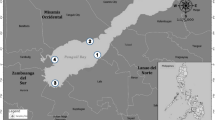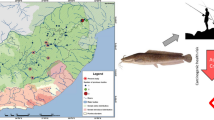Abstract
Eurasian otters (Lutra lutra) are endangered worldwide, but the specific cause of their decline has not been determined. This study analyzed the concentrations of potentially toxic trace elements, including As, Cd, Pb, Hg, Se, Cu, Mn, and Zn, in the liver, kidney, and lung tissues of Eurasian otters in South Korea. There were high individual variations in the tissue concentrations of all the elements analyzed. The kidneys had the highest concentrations of Cd and Se among the three tissue groups, and the livers had the highest concentrations of Cu, Mn, Zn, and Hg. The Pb and As concentrations in the livers were not significantly different from those in the kidneys, and the lungs had the lowest concentrations of all the elements analyzed. The age-related bioaccumulation of Cd and Hg was evident in the three tissue groups, and of Se in the kidneys. The Pb concentration was higher in the livers of juveniles compared with those of adults and the Zn concentration was higher in the lungs of juveniles. There were no apparent gender differences in the concentrations of the elements analyzed among the tissue groups. The Se concentration correlated with the Hg concentration in the livers and kidneys, and with the Cd concentration in the kidneys. The Hg and Cd levels correlated in the three tissue groups. The Cu and Zn levels also correlated in the livers and kidneys. In general, the element concentrations were within the ranges reported by previous studies of this species from European countries, except for Cd and Hg, the levels of which were mostly lower than those reported previously. These findings may provide baseline information to facilitate the conservation of the Eurasian otter. To the best of our knowledge, this is the first available study of trace element concentrations in the tissues of Eurasian otters from South Korea or Asian countries.




Similar content being viewed by others
References
ATSDR (2010) (Agency for Toxic Substances and Disease Registry) CERCLA Priority list of hazardous substances for 2007
Berry MJ, Ralston NVC (2008) Mercury toxicity and the mitigating role of selenium. EcoHealth 5:456–459
Dancey CP, Reidy J (2007) Statistics without maths for psychology: using SPSS for Windows, 4th edn. Pearson/Prentice Hall, Harlow
Djujic IS, Jozanovstankov O, Mandic M, Demajo M, Vrvic MM (1992) Selenium content and distribution in rat-tissues irradiated with gamma-rays. Biol Trace Elem Res 33:197–204
ECB (European Chemical Bureau) (2005) Risk assessment: cadmium metal/cadmium oxide. Ispra, European Chemical Bureau
EEA (European Environment Agency) (2003) http://www.eea.europa.eu/data-and-maps/figures/concentration-of-cadmium-and-mercury-at-river-stations. Accessed May 2014
Eisler R (1997) Copper hazards to fish, wildlife, and invertebrates: a synoptic review. U.S. Geological Survey, Biol. Sci. Rep, BSR-1997-0002, Washington, DC
Evans RD, Addison EM, Villeneuve JY, MacDonald KS, Joachim DG (1998) An examination of spatial variation in mercury concentrations in otter (Lutra canadensis) in South-Central Ontario. Sci Total Environ 213:239–245
Gailer J (2007) Arsenic–selenium and mercury–selenium bonds in biology. Coord Chem Rev 251:234–254
Garcia MHD, Moreno DH, Rodriguez FS, Beceiro AL, Alvarez LEF, Lopez MP (2011) Sex- and age-dependent accumulation of heavy metals (Cd, Pb and Zn) in liver, kidney and muscle of roe deer (Capreolus capreolus) from NW Spain. J Environ Sci Health A 46:109–116
Grove RA, Henny CJ (2008) Environmental contaminants in male river otters from Oregon and Washington, USA, 1994-1999. Environ Monit Assess 145:49–73
Guo CH, Hsia S, Chen PC (2013) Distribution of selenium and oxidative stress in breast tumor-bearing mice. Nutrients 5:594–607
Gutleb AC, Kranz A, Nechay G, Toman A (1998) Heavy metal concentrations in livers and kidneys of the otter (Lutra lutra) from Central Europe. Bull Environ Contam Toxicol 60:273–279
Haines KJ, Evans RD, O’Brien M, Evans HE (2010) Accumulation of mercury and selenium in the brain of river otters (Lontra canadensis) and wild mink (Mustela vison) from Nova Scotia, Canada. Sci Total Environ 408:537–542
Heisinger JF, Hansen CD, Kim JH (1979) Effect of selenium dioxide on the accumulation and acute toxicity of mercuric-chloride in Goldfish. Arch Environ Contam Toxicol 8:279–283
Hoffman DJ, Rattner BA, Scheunert I, Korte F (2001) Environmental contaminants. In: Shore RF, Rattner BA (eds) Ecotoxicology of wild mammals. Wiley, Chichester, pp 1–48
Hyvärinen H, Tyni P, Nieminen P (2003) Effects of moult, age, and sex on the accumulation of heavy metals in the otter (Lutra lutra) in Finland. Bull Environ Contam Toxicol 70:278–284
Kaneko JJ, Ralston NV (2007) Selenium and mercury in pelagic fish in the central north pacific near Hawaii. Biol Trace Elem Res 119:242–254
Kjellström T (1979) Exposure and accumulation of cadmium in populations from Japan, the United-States, and Sweden. Environ Health Perspect 28:169–197
Klenavic K, Champoux L, Mike O, Daoust PY, Evans RD, Evans HE (2008) Mercury concentrations in wild mink (Mustela vison) and river otters (Lontra canadensis) collected from Eastern and Atlantic Canada: relationship to age and parasitism. Environ Pollut 156:359–366
Koeman JH, van de Ven WS, de Goeij JJ, Tjioe PS, van Haaften JL (1975) Mercury and selenium in marine mammals and birds. Sci Total Environ 3:279–287
Kruuk H (1995) Wild otters: predation and populations. Oxford University Press, Oxford
Kruuk H (2006) Otters ecology, behaviour and conservation. Oxford University Press, Oxford
Kruuk H, Moorhouse A (1990) Seasonal and spatial differences in food selection by otters (Lutra-Lutra) in Shetland. J Zool 221:621–637
Kruuk H, Conroy JWH, Webb A (1997) Concentrations of mercury in otters (Lutra lutra L.) in Scotland in relation to rainfall. Environ Pollut 96:13–18
Kwaansa-Ansah EE, Asare-Donkor NK, Adimado AA, Nam D-H (2013) Evaluation of mercury and selenium concentrations in the edible tissue of freshwater fish from the Volta Lake in Ghana. J Environ Occup Sci 2:109–118
Lanszki J, Orosz E, Sugar L (2009) Metal levels in tissues of Eurasian otters (Lutra lutra) from Hungary: variation with sex, age, condition and location. Chemosphere 74:741–743
Lemarchand C, Rosoux R, Berny P (2010) Organochlorine pesticides, PCBs, heavy metals and anticoagulant rodenticides in tissues of Eurasian otters (Lutra lutra) from upper Loire River catchment (France). Chemosphere 80:1120–1124
Lodenius M, Skarén U, Hellstedt P, Tulisalo E (2014) Mercury in various tissues of three mustelid species and other trace metals in liver of European otter from Eastern Finland. Environ Monit Assess 186:325–333
Ma W-C (1996) Lead in mammals. In: Beyer WN, Heinz GH, Redmon-Norwood AW (eds) Environmental contaminants in wildlife: interpreting tissue concentrations. Lewis, Boca Raton, pp 281–296
Mason CF, Macdonald SM (1988) Metal contamination in mosses and otter distribution in a rural welsh river receiving mine drainage. Chemosphere 17:1159–1166
Mason CF, Macdonald SM (2004) Growth in otter (Lutra lutra) populations in the UK as shown by long-term monitoring. Ambio 33:148–152
Mason CF, Madsen AB (1992) Mercury in Danish Otters (Lutra-Lutra). Chemosphere 25:865–867
Mason CF, Stephenson A (2001) Metals in tissues of European otters (Lutra lutra) from Denmark, Great Britain and Ireland. Chemosphere 44:351–353
Mayack DT (2012) Hepatic mercury, cadmium, and lead in mink and otter from New York State: monitoring environmental contamination. Environ Monit Assess 184:2497–2516
Mazet A, Keck G, Berny P (2005) Concentrations of PCBs, organochlorine pesticides and heavy metals (lead, cadmium, and copper) in fish from the Drome river: potential effects on otters (Lutra lutra). Chemosphere 61:810–816
Mochizuki M, Mori M, Hondo R, Ueda F (2008) A new index for evaluation of cadmium pollution in birds and mammals. Environ Monit Assess 137:35–49
MOE (Ministry of Environment, South Korea) (2009) http://www.korea.kr/policy/pressReleaseView.do?newsId=155364867. Accessed May 2014
O’Connor DJ, Nielsen SW (1981) Environmental survey of methylmercury levels in wild mink (Mustela vison) and otter (Lutra canadensis) from the northeastern United States and experimental pathology of methylmercurialism in the otter. Proceedings, World Furbearer Conference. Frostburg, Maryland, USA, pp. 1728–1745
Park K, Shin DC (2004) Environmental risk assessment of cadmium using national monitoring data. J Environ Toxicol 19:65–72
Pavlata L, Illek J, Pechova A (2001) Blood and tissue selenium concentrations in calves treated with inorganic or organic selenium compounds—a comparison. Acta Vet Brno 70:19–26
Pilarczyk B, Pilarczyk R, Tomza-Marciniak A, Hendzel D, Bakowska M, Stankiewicz T (2011) Evaluation of selenium status and its distribution in organs of free living foxes (Vulpes vulpes) from an Se deficient area. Pol J Vet Sci 14:453–457
Roméo M, Mathieu A, Gnassia-Barelli M, Romana A, Lafaurie M (1994) Heavy metal content and biotransformation enzymes in two fish species from the NW Mediterranean. Mar Ecol Prog Ser 107:15–22
Ruiz-Olmo J, Loy A, Cianfrani C, Yoxon P, Yoxon G, de Silva PK, Roos A, Bisther M, Hajkova P, Zemanova B (2008) Lutra lutra. IUCN 2013. IUCN Red List of Threatened Species. Version 2013.2
Skarén U (1992) Analysis of one hundred otters killed by accidents in Central Finland. IUCN Otter Spec. Group Bull., 9–12
Szefer P, Szefer K, Pempkowiak J, Skwarzec B, Bojanowski R, Holm E (1994) Distribution and coassociations of selected metals in seals of the Antarctic. Environ Pollut 83:341–349
Walker LA, Lawlor AJ, Chadwick EA, Potter E, Pereira MG, Shore RF (2010) Inorganic elements in the livers of Eurasian otters, Lutra lutra, from England and Wales in 2007&2008—a Predatory Bird Monitoring Scheme (PBMS) report. Centre for Ecology & Hydrology, Lancaster
Walker LA, Lawlor AJ, Chadwick EA, Potter E, Pereira MG, Shore RF (2011) Inorganic elements in the livers of Eurasian otters, Lutra lutra, from England and Wales in 2009—a Predatory Bird Monitoring Scheme (PBMS) report. Centre for Ecology & Hydrology, Lancaster
Wren CD (1984) Distribution of metals in tissues of beaver, raccoon and otter from Ontario, Canada. Sci Total Environ 34:177–184
Wren CD, Harris S, Harttrup NA (1995) Ecotoxicology of mercury and cadmium. In: Hoffman DJ, Rattner BA, Burton GA Jr, Cairns J Jr (eds) Handbook of ecotoxicology. Lewis, Boca Raton, pp 392–423
Yang DY, Chen YW, Gunn JM, Belzile N (2008) Selenium and mercury in organisms: interactions and mechanisms. Environ Rev 16:71–92
Acknowledgments
This research was supported by the National Research Institute of Cultural Heritage, Cultural Heritage Administration, South Korea (#NRICH-1207-B27F).
Conflict of interest
The authors declare that they have no conflict of interest.
Author information
Authors and Affiliations
Corresponding author
Electronic supplementary material
Below is the link to the electronic supplementary material.
Rights and permissions
About this article
Cite this article
Kang, S., Kang, JH., Kim, S. et al. Trace element analysis of three tissues from Eurasian otters (Lutra lutra) in South Korea. Ecotoxicology 24, 1064–1072 (2015). https://doi.org/10.1007/s10646-015-1447-3
Accepted:
Published:
Issue Date:
DOI: https://doi.org/10.1007/s10646-015-1447-3




